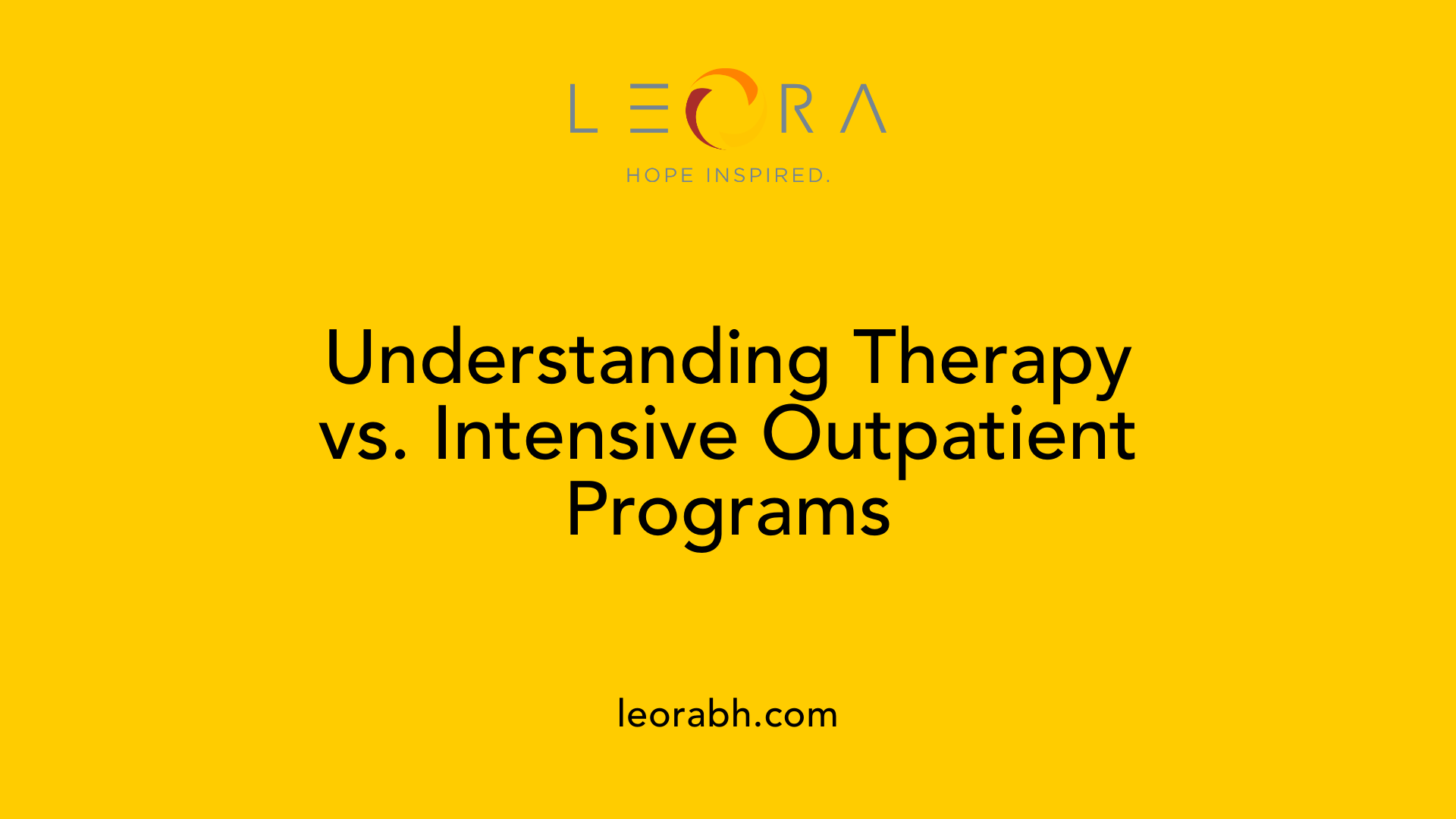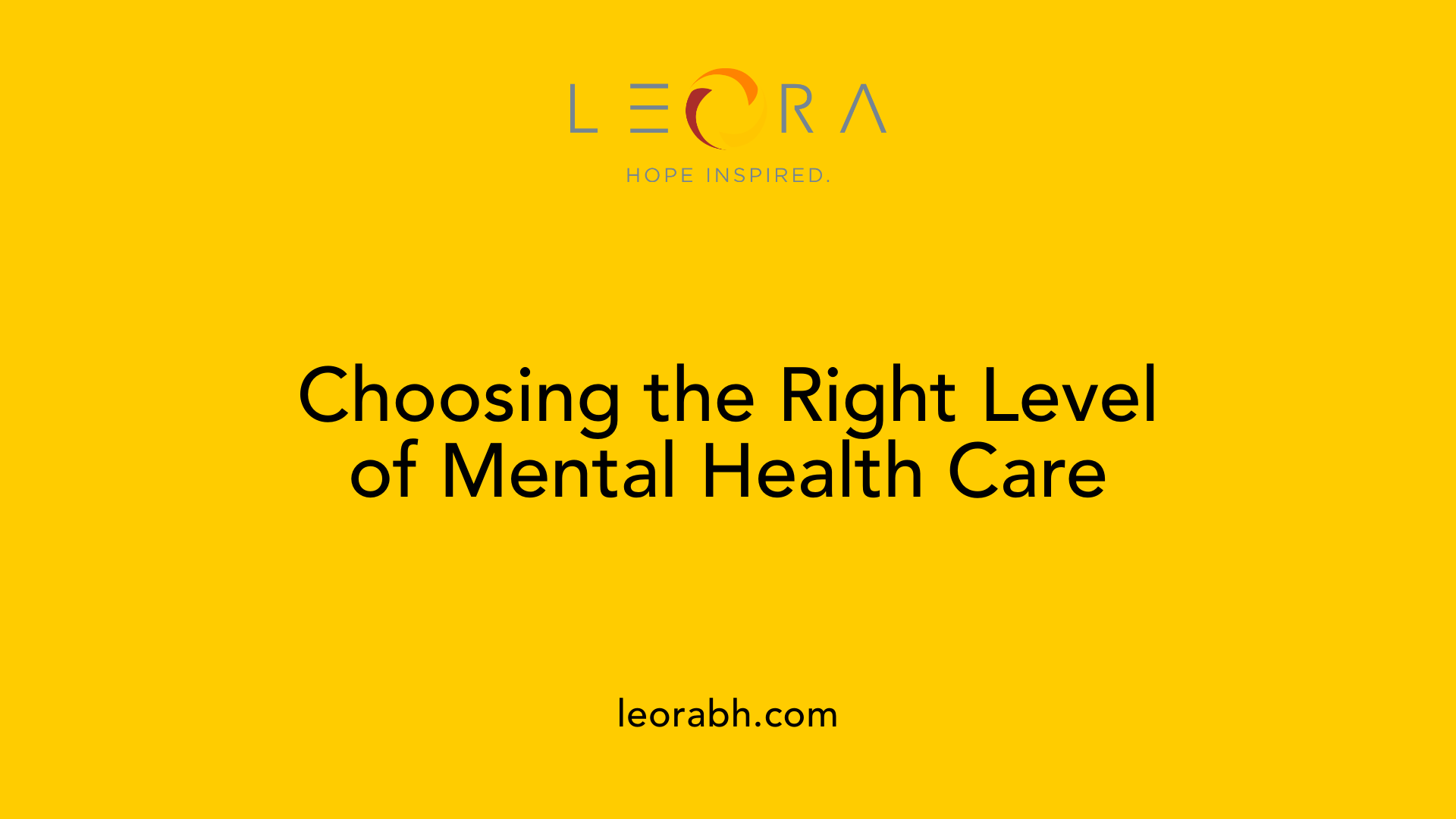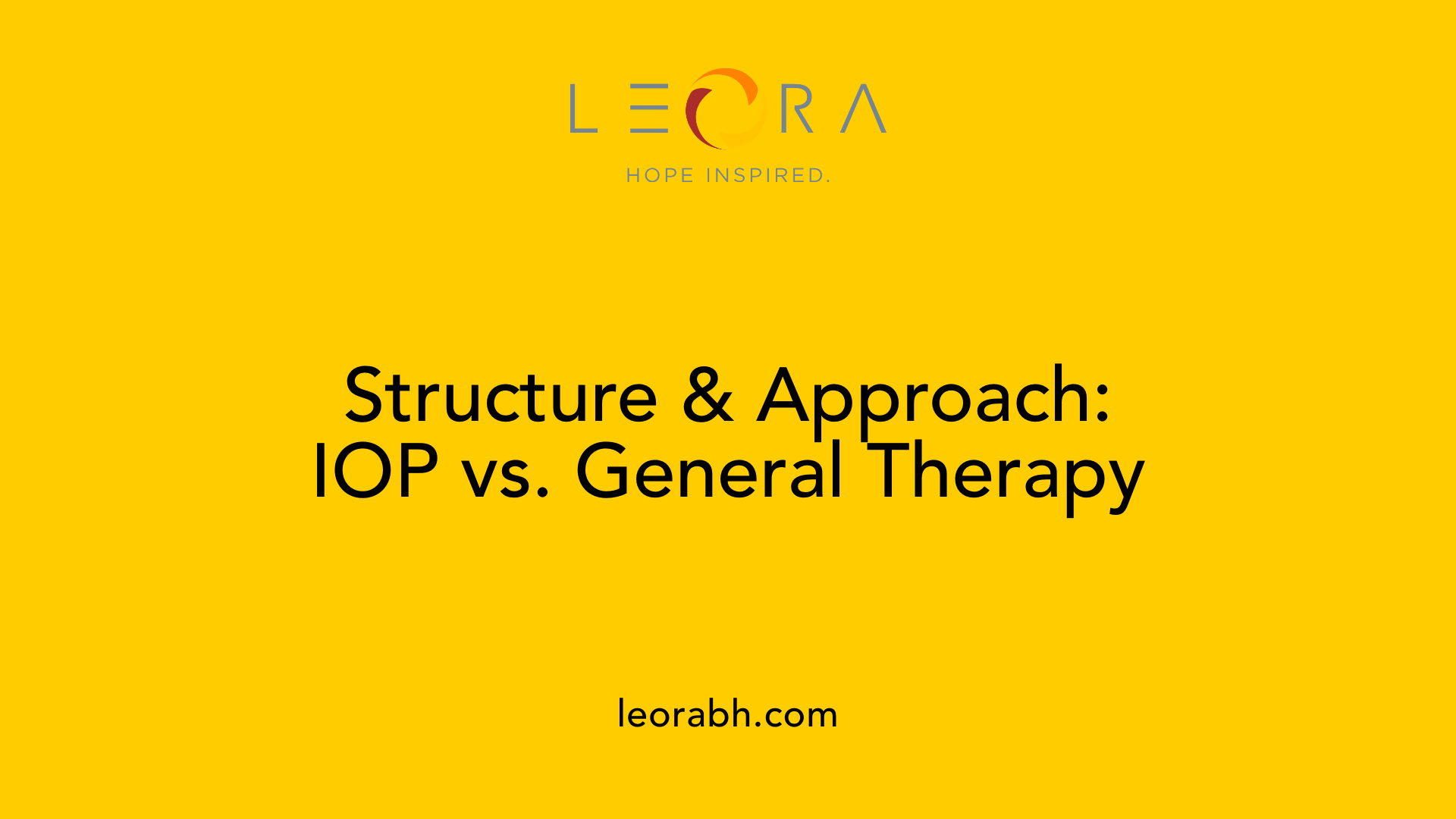The differences between mental health IOP and general therapy
Understanding the Spectrum of Mental Health Care Options
Setting the Stage: Differing Levels of Treatment
Mental health treatment exists on a continuum, ranging from traditional outpatient therapy to highly intensive inpatient care. Knowing how these levels differ in structure, approach, and suitability is key to selecting the most appropriate intervention. This article explores the distinctions between mental health Intensive Outpatient Programs (IOPs) and general therapy, providing clarity on terminology, treatment levels, and when each modality might be most effective.
Defining Therapy and Intensive Outpatient Programs (IOP)

What is the difference between therapy and intensive outpatient therapy?
Traditional therapy mainly involves scheduled sessions with licensed mental health professionals, usually in private offices or online, lasting about 45 minutes to an hour. These sessions are often held weekly and mainly focus on managing mild to moderate mental health issues, promoting personal growth, and developing coping strategies.
In contrast, Intensive Outpatient Programs (IOP) are structured, more comprehensive treatment approaches designed to address more complex mental health or substance use disorders. IOPs typically involve multiple therapy sessions each week, often lasting several hours per session. These programs combine various modalities such as group therapy, individual counseling, family therapy, and psychoeducation. Sessions are usually held in the evenings or on specific days to allow participants to maintain daily responsibilities like work or school.
The key difference between traditional therapy and IOPs is the level of intensity and time commitment. While weekly therapy offers flexibility and is suitable for milder issues or ongoing personal development, IOPs provide a higher level of care suitable for individuals requiring more support due to complex or severe conditions.
Both approaches serve important roles in mental health treatment, and the choice depends on the individual's condition, support system, and specific needs, often guided by professional recommendations.
Features of IOP, including structure, duration, and modalities
Intensive Outpatient Programs are designed to deliver structured care while allowing patients to live at home and continue their daily routines. Typically lasting between 8 to 12 weeks, IOPs involve sessions several times a week, each lasting about 2 to 4 hours. The frequency and length of sessions make IOPs a middle ground between traditional outpatient therapy and inpatient hospitalization.
These programs use various therapeutic modalities tailored to address underlying issues and develop coping skills. Common therapies include cognitive-behavioral therapy (CBT), dialectical behavior therapy (DBT), and motivational interviewing. Additionally, IOPs may incorporate holistic treatments such as meditation, yoga, acupuncture, and massage to support overall well-being.
The structure often includes a combination of group therapy, individual therapy, family sessions, and relapse prevention activities. This diverse approach aims to build resilience, improve emotional regulation, and foster support networks.
People participating in IOP are usually individuals diagnosed with substance use disorders, mood or anxiety disorders, or other mental health conditions that require more than weekly therapy but do not necessitate hospitalization.
In summary, IOP provides intensive, multifaceted treatment tailored to meet the needs of individuals requiring robust support while maintaining daily responsibilities. Its flexible and comprehensive nature facilitates ongoing recovery and skill-building in a supportive environment.
Terminology and Setting of Mental Health Treatments
Understanding the different terms used to describe mental health treatment environments helps clarify the types of care available and their intended purposes. Common phrases include inpatient, outpatient, IOP (Intensive Outpatient Program), and PHP (Partial Hospitalization Program).
Inpatient treatment involves individuals staying overnight at a medical facility. This setup provides 24-hour supervision and support, typically suited for severe mental health crises or when safety is a primary concern. Patients live on-site and receive continuous medical and therapeutic care, often lasting from days to weeks depending on the severity of their condition.
Outpatient treatment, on the other hand, refers to therapy sessions and medical support that do not require overnight stays. Patients attend scheduled appointments, which can range from weekly to monthly, and then return home. This flexibility allows individuals to manage daily responsibilities while engaging in ongoing treatment.
The term IOP, or Intensive Outpatient Program, describes structured treatment options that usually involve attending therapy several times a week for 8-12 hours weekly. These programs include group therapy, individual counseling, and medication management, enabling patients to continue work, school, or family activities.
PHP, or Partial Hospitalization Program, provides a more comprehensive level of outpatient care. Typically, PHP involves 20-30 hours of structured therapy weekly, including medical monitoring and psychiatric evaluations. Patients participate in daily individual and group therapy during the day but return home in the evenings. It is often recommended for those transitioning from inpatient care or with more intensive needs.
The choice among these treatment settings depends on the severity of the mental health condition, safety considerations, and the individual's support system. PHP offers a higher level of care than IOP, with more hours of treatment, while outpatient and IOP services provide varying degrees of flexibility to suit different lifestyles.
Understanding this terminology helps patients, families, and healthcare providers select the appropriate setting for effective mental health management.
Levels of Care and When to Use Them

What are the different levels of mental health care, including outpatient options like IOP?
Mental health care is tailored to the severity and specific needs of each individual, offering a range of options from intensive inpatient programs to less formal outpatient services.
Inpatient care is the most comprehensive level, providing 24/7 supervision and medical support for those experiencing severe mental health crises or acute episodes. Patients typically stay in a hospital or residential facility for days to a few weeks, depending on their condition and treatment plan.
Partial Hospitalization Programs (PHP) serve as a highly structured daytime care option. Usually lasting between four to six weeks, PHP involves several hours of therapy each day, including individual, group, and family sessions, along with psychiatric support and medication management. Patients return home in the evenings, which helps them transition from inpatient care or provides intensive support for ongoing treatment.
Intensive Outpatient Programs (IOP) are less demanding but still provide a significant level of support. Patients attend therapy sessions multiple times a week, often lasting 2-4 hours per session. This format allows individuals to continue their daily routines—such as work or school—while receiving structured therapy, skill development, and relapse prevention. IOPs are suitable for those with moderate symptoms or as a bridge after completing less intensive treatments.
Traditional outpatient treatment mainly involves weekly or biweekly individual or group therapy sessions, each typically lasting 45-60 minutes. This level is ideal for people managing mild symptoms, or as a maintenance phase after more intensive treatment. Outpatient services focus on ongoing support, medication monitoring, and learning coping strategies, suited for those with mild to moderate issues or stable recovery.
By understanding these levels—ranging from inpatient hospitalization to outpatient therapy—individuals and clinicians can select the most appropriate approach, ensuring effective, personalized mental health care.
| Level of Care | Typical Duration | Intensity & Services | Ideal For |
|---|---|---|---|
| Inpatient Hospitalization | Days to weeks | 24/7 supervision, crisis stabilization, medical and psychiatric support | Severe or crisis situations, need for constant monitoring |
| Partial Hospitalization (PHP) | 4-6 weeks, daily sessions | Structured daily therapy, family and individual counseling, medication management | Significant support needs, transition from inpatient care |
| Intensive Outpatient (IOP) | 8-12 weeks, 2-4 hours per session | Several days a week, group & individual therapy, relapse prevention | Moderate symptoms, need for ongoing support without full-time commitment |
| Outpatient Therapy | Ongoing, weekly or biweekly | Weekly therapy sessions, medication management, support groups | Mild symptoms, ongoing maintenance, stable recovery |
Choosing the right level depends on assessing symptom severity, stability, and personal circumstances, ensuring individuals receive the most suitable and effective care.
Structural and Therapeutic Differences Between IOP and General Therapy

What are the differences in structure and approach between mental health intensive outpatient programs (IOP) and general therapy?
Intensive Outpatient Programs (IOPs) are more structured and require a higher time commitment than traditional, general therapy. Typically, IOPs involve attending sessions multiple times per week, with each session lasting about 2 to 4 hours. These sessions often include both group therapy and individual counseling, alongside other therapeutic activities such as skills training and relapse prevention. The goal is to provide comprehensive, multidisciplinary support that addresses complex mental health issues or substance abuse while allowing individuals to maintain their daily routines.
In contrast, traditional therapy usually involves weekly sessions of around 45 to 60 minutes. These sessions are more flexible in scheduling and focus on addressing specific issues like anxiety, depression, or trauma. The therapeutic approaches frequently used in general therapy include Cognitive Behavioral Therapy (CBT), Dialectical Behavioral Therapy (DBT), and Acceptance and Commitment Therapy (ACT). These are aimed at symptom management, personal growth, and developing coping skills.
The main difference lies in the intensity and scope of treatment. IOPs are designed for individuals who need a comprehensive, supervised treatment environment but do not require inpatient care. They aim to support stabilization, recovery, and relapse prevention, often helping clients transition from inpatient or residential treatment. General therapy, on the other hand, provides ongoing, less frequent support suited for those with milder symptoms or as part of a long-term personal or mental health management plan.
Overall, IOPs offer a highly structured, intensive approach, integrating various therapies and support systems, while general therapy emphasizes flexible, regular sessions focused on specific issues and ongoing personal development.
Candidate Suitability and Decision-Making

Who are suitable candidates for IOP versus general therapy?
Intensive Outpatient Programs (IOPs) are designed for individuals who need more support than what traditional outpatient therapy offers but do not require inpatient hospitalization. Suitable candidates usually have mild to moderate symptoms related to mental health or substance use disorders. They typically reside in a stable environment and have access to reliable social or family support systems.
Candidates for IOP are motivated to participate actively in structured treatment while maintaining daily responsibilities like work, school, or family commitments. Many have completed residential or partial hospitalization programs and are transitioning back into regular routines with continued, more flexible support. IOP includes group therapy, individual counseling, medication management, and life skills training, making it effective for those who can manage their recovery outside a hospital setting.
In contrast, general outpatient therapy is suitable for individuals experiencing mild issues or emotional challenges that can be addressed effectively with weekly or biweekly sessions. These individuals usually have stable environments and fewer symptoms that interfere significantly with daily life. They do not require intensive or structured programs, and their conditions can often be managed with standard individual or group therapy.
People who lack stability at home, have severe mental health conditions, or require constant supervision are generally not suitable for IOP or outpatient therapy. Instead, they might need inpatient treatment or residential care, where around-the-clock medical and therapeutic support is available. Recognizing the appropriate treatment level based on individual circumstances ensures the best chances of recovery and stability.
Indicators for different treatment levels
The decision between outpatient services like IOP, PHP, and inpatient programs depends on several factors:
| Treatment Level | Suitable For | Severity of Symptoms | Key Indicators | Support System | Duration | Typical Settings |
|---|---|---|---|---|---|---|
| General Outpatient | Mild to moderate issues | Mild to manageable | Mild emotional disturbances | Strong or limited support | Short-term, flexible | Private practices, clinics |
| IOP | Moderate symptoms needing structured support | Moderate | Recurring crises, risk of relapse | Stable environment, motivation | Several weeks, part-time | Day programs, virtual options |
| PHP | Severe symptoms needing daily supervision | Moderate to severe | Post-inpatient transition, ongoing stabilization | Support network present | 4-6 weeks | Hospital outpatient units |
| Inpatient | Severe crises, safety risk | Severe | Suicidal ideation, psychosis, safety concern | Not required | Days to weeks | Hospital, residential units |
Choosing the right treatment level involves assessing symptom severity, support network strength, ability to manage responsibilities, and safety considerations. Proper matching enhances recovery outcomes and ensures patients receive the care they need at the appropriate intensity.
Treatment Goals and Impact of Therapy Types

How do treatment goals and focus areas differ between IOP and traditional outpatient therapy?
Intensive Outpatient Programs (IOPs) and traditional outpatient therapy serve different purposes based on the severity of symptoms and individual needs. IOPs aim to stabilize individuals experiencing moderate to severe mental health issues or recovering from inpatient care. They focus on immediate symptom management, relapse prevention, and developing coping skills through structured schedules that include group therapy, individual counseling, medication management, and life skills training.
These programs are designed to provide comprehensive support during critical recovery phases, allowing individuals to maintain daily responsibilities like work or school while receiving intensive treatment. The primary goal is to prevent deterioration and support ongoing recovery, emphasizing peer support and skill application in real-life settings.
In contrast, traditional outpatient therapy is generally less intensive and more flexible. It is mainly aimed at individuals with milder or well-controlled symptoms who seek ongoing personal growth, symptom management, or support for specific issues such as trauma or anxiety. Sessions typically occur once a week or every other week, focusing on exploring underlying issues, maintaining progress, and fostering long-term resilience.
While IOPs focus on stabilizing and addressing acute or complex issues rapidly, outpatient therapy helps individuals deepen their understanding of their conditions, improve emotional regulation, and promote sustained recovery over time. The structure and intensity of these therapies reflect their different roles in the continuum of mental health care.
Choosing the Right Level of Care for Effective Recovery
Understanding the nuanced differences between mental health IOPs and general therapy is essential for making informed treatment decisions. While traditional therapy offers valuable ongoing support for milder symptoms or personal growth, IOPs serve as a bridge for those needing more intensive, structured intervention without full hospitalization. Recognizing individual needs, severity of symptoms, and lifestyle considerations will ensure that individuals receive the most appropriate level of care to support their journey toward mental wellness.
References
- Outpatient Mental Health Treatment vs. Traditional Therapy
- Outpatient Programs: PHP vs IOP | Turning Point Care Center
- What Is PHP/IOP? | Treatment Options Explained
- Differences Between IOP, PHP, & Inpatient Programs for Mental Health
- What's the Difference Between General Outpatient and an Intensive ...
- Types of Mental Health Providers and Services | myUSF
- Intensive Outpatient Programs vs Inpatient Treatment - Charlie Health
Find Your Inner Light
Related Articles
Schedule an Assessment
Leora Behavioral Health provides comprehensive treatment services, including ambulatory detox, mental health IOP, and SUD IOP, to support your journey toward lasting recovery.
Our caring team will guide you through the admissions process and create a personalized treatment plan tailored to your unique needs. We welcome walk-ins. If you or a loved one is struggling, reach out today. We’re here to help.


.svg)




.svg)
.svg)
.svg)
.svg)
